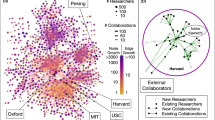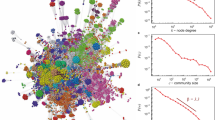Abstract
Academic research groups are treated as complex systems and their cooperative behaviour is analysed from a mathematical and statistical viewpoint. Contrary to the naive expectation that the quality of a research group is simply given by the mean calibre of its individual scientists, we show that intra-group interactions play a dominant role. Our model manifests phenomena akin to phase transitions which are brought about by these interactions, and which facilitate the quantification of the notion of critical mass for research groups. We present these critical masses for many academic areas. A consequence of our analysis is that overall research performance of a given discipline is improved by supporting medium-sized groups over large ones, while small groups must strive to achieve critical mass.






Similar content being viewed by others
References
Biely, C., Hanel, R., & Thurner, S. (2009). Socio-economical dynamics as a solvable spin system on co-evolving networks. European Physical Journal B, 67, 285–290.
Bittner, E., Nußbaumer A., & Janke, W. (2007). Self-affirmation model for football goal distributions. Europhysics Letters, 78, 58002.
Dorogovtsev, S. N., & Mendes, J. F. F. (2003). Evolution of networks. Oxford: Oxford University Press.
Galam, S. (2004). Sociophysics: A personal testimony. Physica A, 336, 49–55.
Harrison, M. (2009). Does high quality research require critical mass?. In D. Pontikakis, D. Kriakou, & R. van Baval (Eds.), The Question of R&D specialisation: Perspectives and policy implications (pp. 57–59). European Commission: JRC Technical and Scientific Reports.
Holovatch, Yu. http://194.44.208.227/~hol/research.html.
Kenna, R., & Berche, B. (2010). The extensive nature of group quality. Europhysics Letters. doi:10.1209/0295-5075/90/58002.
King, D. A. (2004). The scientific impact of nations. Nature, 430, 311–316.
Kondrat, G., & Sznajd-Weron, K. (2010). Spontaneous reorientations in a model of opinion dynamics with anticonformists. International Journal of Modern Physics C, 21, 559–566.
Nußbaumer, A., Janke, W., & Weigel, M. (2009). Football fever: Goal distributions and non-Gaussian statistics. International Journal of Modern Physics B, 67, 459.
Parisi, G. (1999). Complex systems: A physicist’s viewpoint. Physica A, 263, 557–564.
Acknowledgments
We are grateful to Neville Hunt for inspiring discussions as well as for help with the statistical analyses. We also thank Arnaldo Donoso, Christian von Ferber, Housh Mashhoudy and Andrew Snowdon for comments and discussions, as well as Claude Lecomte, Scientific Delegate at the AERES, for discussions on the work of that agency.
Author information
Authors and Affiliations
Corresponding author
Additional information
B. Berche—Laboratoire associé au CNRS UMR 7198.
Rights and permissions
About this article
Cite this article
Kenna, R., Berche, B. Critical mass and the dependency of research quality on group size. Scientometrics 86, 527–540 (2011). https://doi.org/10.1007/s11192-010-0282-9
Received:
Accepted:
Published:
Issue Date:
DOI: https://doi.org/10.1007/s11192-010-0282-9




